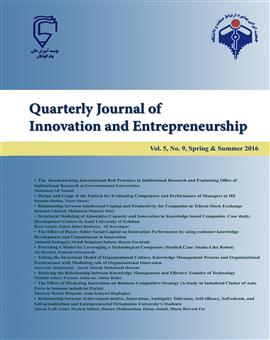Studying the relationship between knowledge management and effective transfer of technology
Subject Areas :عباس رفیعی 1 , mostafa jafari 2 , peyman akhavan 3
1 -
2 -
3 -
Keywords: technology transfer, knowledge management, technology, knowledge capability, effectiveness,
Abstract :
The aim of the research is to identify knowledge factors effective in designing and absorbing technology in knowledge-based centers and manufacturing industries, and to survey the effect of knowledge management on each factor, and successful technology transfer. The research method is descriptive of correlation type. In this research, using a simple stochastic method ,151 active people in technology transfer were selected from among scientific and research groups and 277 were selected from among large manufacturing industries. The data for the research were collected through questionnaires. Confirmed construct and factorial analysis were used to determine the validity, and for reliability, Chronbach alpha was employed. In order to study the relationship between research variables and to study hypotheses, the modeling of structural equations has been used with the help of SPSS and AMOS software.Findings indicate that there is a , significant, and positive relationship between knowledge management and technology effectiveness transfer. The only difference is that, knowledge management impacts directly on technology effectiveness transfer only in knowledge-based centers. Likewise, knowledge management indirect impact on successful technology transfer only through knowledge capability whose impact is on knowledge-based centers (35%)and on manufacturing industries(77%) .
Akhavan ,P.and Ramezan ,M. and Yazdi Moghadam ,J.(2013) . Examining The role of ethics in Knowledge Management process.Journal of Knowledge Management –based Innovation in china.vol .5 No.2, pp,129-145
Albino, V., Garavelli, A. C. And Schiuma, G. (1999). Knowledge Transfer And Inter-Firm Relationships In Industrial Districts: The Role Of The Leader Firm. Technovation 19,53-63.
Asghari ,M . and Pakhshanikia , M .(2013) .Technology Transfer in Oil Industry , Si , gnificance and Challenges Original Recearch Article Procedia – Social and Behavioral Sciences 75 ,pp 264-271.
Billiet, J. ,et al. (2003). Cross-cultural equivalence with structural equation modeling. John Wiley and Sons, Hoboken, NJ, pp. 247-264.
Bishop, K., D’este, P. And Neely, A. (2011). Gaining From Interactions With Universities: Multiple Methods For Murturing Absorptive Capacity. Research Policy 40, 30-40.
Bohhn, R . E. (1994). Measuring And Managing Technology Knowledge, Sloan Management Review, Vol. 36, No. 1,pp. 61-73.
Carayannis, E. G., Alexander, J. And Loannidis, A. (2000). Leveraging Knowledge, Learning, And Innovation In Forming Strategic Govermment-University-Industry (Gui) R&D Partnerships In The Us, Germany, And France. Technovation 20, 477-488.
Carolina Lopez-Nicolas*, Angel L.Merono-Cerdan, (2011) Strategic Knowledge Management, Innovation And Performance, International Journal Of Information Management 31, 502-509.
Chen, C.& Huang, J .(2009). Strategic Human Resource And Innovation Performance – The Mediating Role Of Knowledge Management Capcity,Journal Of Buisiness Research,Vol.62,No.1,pp.104-114
Cheung, G. W., & Rensvold, R. B. (2002). Evaluating goodness-of-fit indexes for testing measurement invariance. Structural equation modeling, 9(2), 233-255.
Darroch, J. (2003). Developing A Measure Of Knowledge Management Behaviors And Practices. Journal Of Knowledge Management,Vol. 7,No.5, pp.41-54.
Davenport T, And Prusak L. (1998). Working Knowledge, Hardvard Business School Press, Boston.
Decter, M., Bennett, D. And Leseure, M. (2007). University To Business Technology Transfer- Uk And Usa Comparisons. Technovation 27, 145-155.
Gallivan, M. (2005). Information Technology And Culture, Information And Organization, 15, 295-338.
Gupta, A., & Govindarajan, V. (2000). Knowledge Flows Within Multinational Corporation. Strategic Management Journal,Vol. 21,No.4,pp. 473-496.
Harrington, S. (2005). Corporate Culture, Absorptive Capacity And It Success, Information And Organization, 15, 39-63.
Human,Haidar Ali(2005),Structural equation modeling using lisrel software,Tehran, one publish , samt Issuance,(In Persian)
Horn, J. L., & McArdle, J. J. (1992). A practical and theoretical guide to measurement invariance in aging research. Experimental aging research, Vol.18,No.3,pp. 117-144.
Jonson ,James ,. (1998),culture , freedom, economic growth , World Business ,Vol.33,No..4,pp.332-356
Kodama, T. (2008). The Role Of Intermediation And Absorptive Capacity In Facilitating University-Industry Linkages: An Empirical Study Of Tama In Japan. Research Policy 37, 1224-1240.
Marques , J . P . C ., Caraca , J . M . G . and Diz , H . (2006) . How can university-industry- government interactions change the innovation scenario in potugal? – the case of the University of Coimbra . Technovation 26 , 534-542.
Monavvarian, A. and Aslgari,N. and Akhavan , p. and Ashena,M.(2013).Developing Social Capital for Facilitating Knowledge Management Practices. International Journal of Social Economics. Vol,40.No .9,pp.826-844.
Mu, J., Tang, F. And Maclachlan, D. L. (2010). Absorptive And Disseminative Capacity: Knowledge Transfer In Intra-Organization Networks. Expert Systems With Applications 37, 31-38.
Pertusa-Ortega, E. M., Zaragoza-Saez, P. And Claver-Cortes, E. (2010). Can Formalization, Complexity, And Centralization Influence Knowledge Performance? Journal Of Business Research 63, 310-320.
Ramin mehr, Hamid and Charsetad,Parvaneh(2013), Quantitative Research method using structural equation modeling(Lisrel software),Tehran,Terme issuance, one publish,(In persian)
Reisman, A. (2005). Transfer Of Technologies, A Cross Disciplinary Taxonomy, Omega, 33, 189-202.
Shaojie, A. (2006). The Influence Of Market, Cultural, Environmental Factors On Technology Transfer, Journal Of World Business, 41, 100-111.
Steenkamp, Jan-Benedict EM, and Hans Baumgartner(1998). Assessing measurement invariance in cross-national consumer research. Journal of consumer research.
Stock, G. (2001). Organizational And Strategic Predictors Of Manufacturing Technology Implementation Success, Technovation, 21, 625-636.
Stock, Gregory N, (2000). A Typology Of Project Level Technology Transfer Processes, Journal Of Operations Management 18, 719-737.
Wang, P. (2004). An Integrated Model Of Knowledge Transfer, World Business, 39, 168-182.
Wei-Wen Wu*, (2012). Segmenting Critical Factors For Successful Knowledge Management Implementation Using The Fuzzy Dematel Method, Applied Soft Computing 12, 527-535.
Yuling Wang*, Jianguo Zheng, (2010) . Knowledge- Management Performance Evaluation Based On Triangular Fuzzy Number, Procedia Engineering 7, 38-45.


